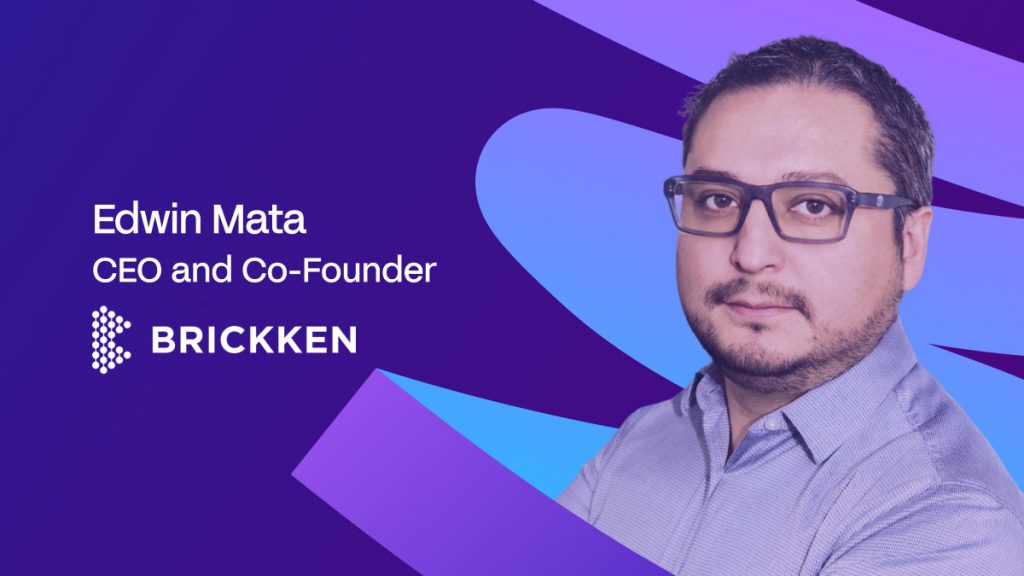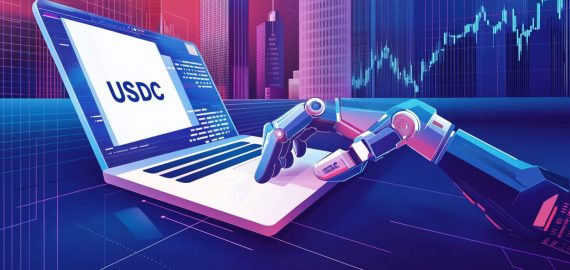What Happens When Blockchain Meets Real-World Assets at Scale


In Brief
Edwin Mata, CEO and Co-founder at Brickken, discusses the evolving financial infrastructure, the role of AI, and the factors driving the adoption of on-chain solutions.

As tokenization gains momentum and blockchain becomes more integrated into traditional finance, the asset management landscape is undergoing a structural shift. In this interview, Edwin Mata, CEO and Co-founder at Brickken, shares his perspective on the evolution of financial infrastructure, the role of emerging technologies like AI, and the key factors driving the adoption of on-chain solutions.
Brickken has utilized over $300 million in assets globally. What has been the primary driver behind this growth?
The main driver behind reaching over 300 million dollars in tokenized assets has been the convergence of blockchain’s structural advantages and Brickken’s relentless focus on execution. Blockchain enables real-time settlement, embedded compliance, transparent ownership, and fractionalization. These are not incremental upgrades, they represent a foundational shift in how capital is created, managed, and transferred.
This is no longer a theoretical proposition. BlackRock’s BUIDL fund, launched on Ethereum through Securitize, has surpassed 2.8 billion dollars in assets under management. Fidelity has developed institutional-grade custody for digital assets. Franklin Templeton has tokenized mutual funds on public blockchains. JPMorgan’s Kinexys platform, formerly Onyx, has processed over 1.5 trillion dollars in tokenized transactions, including intraday repo and collateral settlements. HSBC, Siemens, ABN AMRO, UBS, and others have issued bonds and structured products on-chain. This level of institutional validation confirms that tokenization is no longer an emerging concept, it is becoming embedded infrastructure.
At Brickken, we anticipated this shift early and built accordingly. We designed an enterprise-grade platform that serves real-world issuers across 16 jurisdictions, offering legally compliant token issuance, investor onboarding, governance, and treasury automation. What sets us apart is our ability to move fast, adapt to market signals, and prioritize user experience without compromising on compliance or scale.
This is not the result of speculation. It is the result of understanding where capital markets are heading, delivering what the market needs before it asks for it, and executing consistently. That is what pushed Brickken past 300 million dollars in tokenized assets, and it is only the beginning.
How do you envision blockchain transforming the future of asset management?
Blockchain is fundamentally redefining the infrastructure behind asset management. At its core, it enables real-time reconciliation and settlement, removing the delays and counterparty risks that exist in today’s fragmented systems. Transactions become atomic, reducing exposure and eliminating the need for multiple layers of intermediaries.
More importantly, blockchain introduces native ownership at the protocol level. Investors can hold and transfer assets with full transparency and direct control, without relying on custodians, registrars, or transfer agents. This shift is especially powerful in private markets, where ownership structures have traditionally been opaque and operationally burdensome.
Capital formation becomes more efficient. Issuers can launch investment vehicles, raise funds, and distribute proceeds using smart contracts, automating functions that would otherwise require legal, administrative, and banking infrastructure. Distributions, redemptions, interest payments, and governance processes can all happen on-chain, with built-in compliance and auditability.
For asset managers, this means lower operational costs, faster liquidity cycles, greater access to global investors, and data-rich reporting environments. For end investors, it means transparency, programmability, and access to opportunities that were previously out of reach.
In short, blockchain transforms asset management from a fragmented, intermediary-heavy industry into a streamlined, programmable financial layer. It does not just digitize existing systems. It replaces them.
Can you elaborate on the enterprise-grade solutions you are developing, and how they align with your mission to reshape asset management?
While I cannot disclose full details yet due to pending regulatory approvals, what I can share is that Brickken is entering a new phase. We are transitioning from being purely a software provider to becoming a fully licensed player capable of operating within the regulated financial infrastructure. This includes the ability to offer custody and brokerage services, which are fundamental pillars for institutional-grade tokenization.
Up until now, we have focused on building best-in-class infrastructure for token issuance, investor onboarding, lifecycle management, and on-chain governance. That continues. But we are now integrating the legal and regulatory layers required to move from facilitation to full execution. This means that we will not only provide the tools for asset tokenization and management, but also be the regulated counterparty that enables these transactions to happen compliantly.
Our ambition is to close the year positioned as a comprehensive infrastructure provider, offering technology, compliance, and legal execution in one vertically integrated stack. This evolution is essential to reshape asset management in a way that meets both market demand and regulatory scrutiny.
In the previous reports, you’ve mentioned plans to introduce AI agents. How do you intend to implement them, and what role could they play in the future of asset management?
AI is not a replacement for expertise, but a powerful tool to simplify complexity. Our goal is to eliminate the need for deep legal or technical knowledge when implementing tokenization. Think of it as having an expert by your side at all times, not just to provide support, but to execute actions when needed.
We are integrating AI across two levels. At the structural level, the AI will guide issuers and asset owners through processes like asset onboarding, legal structuring, investor compliance, and token issuance. At the execution level, the AI will be action-oriented, connecting to our APIs and allowing users to perform tasks through simple, conversational interfaces. Whether you’re in Brickken’s application or using external environments like Slack, Telegram, or Discord, the AI agent can initiate, execute, and automate key operations in real time.
This makes the experience radically more intuitive. Instead of navigating multiple dashboards or relying on back-and-forth with intermediaries, users can launch, manage, and monitor tokenized assets directly from where they already operate.
The result is a seamless blend of compliance-grade infrastructure with AI-driven simplicity. It’s not just a support layer, it’s an operational co-pilot embedded across the asset management lifecycle. It’s a powerful shift, and a critical part of our strategy to make tokenization accessible at scale.
What is your perspective on the potential of tokenization and tokenized investments across both retail and institutional markets? Will it fuel institutional adoption?
Tokenization is not just a new product category, it is a structural overhaul of how capital is formed, deployed, and managed. It will drive adoption across both retail and institutional markets because it improves the underlying mechanics of financial infrastructure.
For institutions, tokenization brings automation, transparency, and speed to cross-border investment processes, significantly reducing operational friction. Capital can be deployed faster, with real-time compliance, programmable governance, and full visibility throughout the asset lifecycle. This enables not only efficiency, but trust at scale.
For retail investors, tokenization unlocks access. High-quality assets that were once limited to institutional channels can now be fractionalized and made investable under clear regulatory conditions. This is not just about breaking assets into smaller pieces. It’s about making the entire investment lifecycle more accessible, more secure, and more efficient.
But more importantly, this is the foundation of a new financial architecture, one where traditional banking, legal enforceability, and blockchain infrastructure converge. We’re moving toward a hybrid model, where digital-native assets, tokenized real-world assets, and regulated financial products all coexist within the same programmable environment.
Tokenization is not a trend. It’s the infrastructure layer of next-generation finance. And yes, it will absolutely fuel institutional adoption, but it will also redefine the playing field for everyone.
How do you see RWA tokenization reshaping global trading and liquidity over the next five years?
Over the next five years, RWA tokenization will shift liquidity from being permissioned and periodic to being continuous and global. Assets that were locked in static ledgers will move onto programmable rails, enabling them to be traded, collateralized, or fractionalized in real time. This isn’t about making private markets slightly more efficient, it’s about rebuilding the core mechanics of asset movement to reflect how modern capital behaves: digital, fast, and borderless.
What challenges and opportunities have you faced in the RWA tokenization space? Can you share the biggest challenge Brickken encountered while developing your platform in this market?
The biggest challenge has been timing around adoption. While we doubled down early on the belief that tokenization and on-chain finance would reshape capital markets due to their clear structural advantages, there was a period where the industry felt more theoretical than practical. From 2020 to 2022, infrastructure, regulation, and institutional readiness were still catching up. But that changed radically starting in 2023.
Major asset managers began launching tokenized funds, regulatory frameworks matured, and real capital began to move on-chain. That shift validated our early conviction and positioned us to scale with a platform already built for real-world deployment. What was once a challenge has become our strategic advantage.
What key trends or themes are you closely monitoring as you shape Brickken’s global strategy?
One of the key trends we’re closely monitoring is the convergence between traditional finance and blockchain, particularly through the adoption of stablecoins by banks and the growing duality of custody between legal tender and tokenized money. As regulated institutions begin to offer stablecoin rails alongside fiat accounts, the line between Web2 and Web3 disappears.
This moment marks a structural shift, when traditional users become blockchain participants without needing to change behavior. For Brickken, this convergence is critical, as it accelerates institutional adoption and enables seamless capital flow across both ecosystems.
You’ve recently secured funding to support platform development in the EU. With growing regulatory oversight—such as the implementation of MiCA—how do you foresee the future of tokenized securities evolving in the region?
Regulation brings trust, and in the context of tokenized securities, that trust is essential for institutional adoption. But regulation is also a double-edged sword. It raises the bar for newcomers who see tokenization purely as a technological opportunity, without understanding that securities are a highly regulated domain. In the EU, MiCA and related frameworks create clear paths for compliance, but they also impose significant constraints on how and when products can be brought to market.
The future in this region depends on striking the right balance, one where innovation is not suffocated, but where opportunistic actors looking for quick monetization at the expense of investor protection are kept out.
How is Brickken adapting to the MiCA framework, and what broader implications do you anticipate for the tokenization space as a whole?
We can’t reveal details yet, but what we’re building under MiCA will set a new benchmark for tokenized infrastructure in Europe, this will be talked about.
Disclaimer
In line with the Trust Project guidelines, please note that the information provided on this page is not intended to be and should not be interpreted as legal, tax, investment, financial, or any other form of advice. It is important to only invest what you can afford to lose and to seek independent financial advice if you have any doubts. For further information, we suggest referring to the terms and conditions as well as the help and support pages provided by the issuer or advertiser. MetaversePost is committed to accurate, unbiased reporting, but market conditions are subject to change without notice.
About The Author
Victoria is a writer on a variety of technology topics including Web3.0, AI and cryptocurrencies. Her extensive experience allows her to write insightful articles for the wider audience.
More articles

Victoria is a writer on a variety of technology topics including Web3.0, AI and cryptocurrencies. Her extensive experience allows her to write insightful articles for the wider audience.

















































